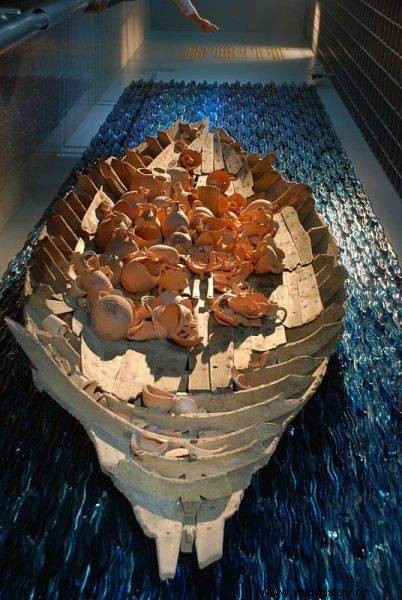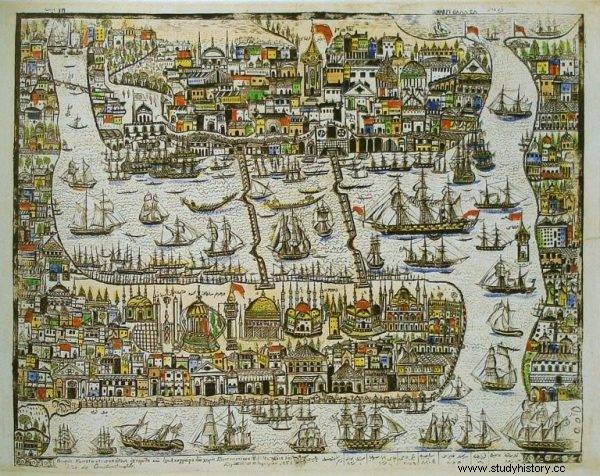Escape excavations carried out since 2004 in the Yenikapi harbor area of Istanbul have uncovered the remains of 37 merchant ships and their wealth.
It is the largest group of such vessels ever found in the area of one ancient port. Beneath the sleepers of ships that were once active in maritime trade, a stunning collection of original archaeological relics and loads of exotic food items such as almonds, hazelnuts, melon seeds, peaches and pine cones have been unveiled.
Ancient port metro station?
In Istanbul (ancient Constantinople), the ruins of an ancient port were discovered during archaeological research preceding the construction of a metro line crossing the Bosphorus Strait. The work was carried out by two independent missions:from Istanbul University and the Institute of Nautical Archeology. Apart from the architectural remains related to the functioning of the port - founded by Theodosius I in the 4th century CE. - and with the lives of its inhabitants, numerous shipwrecks and ships that sank to the bottom of the marina were also found.

Yenikapi - wreck with a cargo of amphorae at the bottom of the hull
© Acar54, under license CC BY-SA 4.0, via Wikimedia Commons
As it turned out, since ancient times the shoreline of the port of Constantinople moved back much further than expected, which is why archaeologists were surprised to find such a dense port development. Most of the units sunk in the mud quagmire of today's site are dated from the 6th to the 7th century AD.
The most numerous group of wrecks in the world
Due to favorable humid conditions for the deposition of objects, the wooden hulls of 37 ships are complete and well preserved. In 2015, the research team discovered a group of five merchant ships and two rowing warships. As reported by Cemal Pulak from the Institute of Nautical Archeology in Texas, the merchant ships were massive and, thanks to their rounded shape, could easily break through the waves, while the longitudinal war galleys were built of light wood ensuring flexibility and speed. The analyzes of the boards from the ships indicate that the best and expensive material was used for their construction.

19th century engraving showing the sailing movement in the Bosphorus
© K. Kaldis - scan from A Guide to the Benaki Museum, Angelos Delivorrias, Public Domain
The planking is made of black pine, a species of conifer brought to Constantinople from the north of the Balkan Peninsula. The wood used to build the merchant ships was heavier and of much lower quality. They were usually planks of Burgundy oak - an easily available building material that grows in Asia Minor.
Sea riches and camels
The rich loads and equipment of the boats have survived to our times. In addition to a large collection of amphorae and resource vessels to transport wine, oil, fruit and nuts such as hazelnuts and almonds, and garum - a fermented fish sauce, wooden combs, dice, sandals and kitchen utensils were also found beneath the ship decks. that is, items used on a daily basis by the crew of sunken ships.

Byzantine oil lamps from the port
© Gryffindor under license CC BY-SA 4.0, via Wikimedia Commons
The bones of camels transported from Africa to Constantinople turned out to be very interesting finds. They were probably brought into the city during the construction of the port to help carry heavy materials. The bones of young horses found near the piers and piers, uncovered by archaeologists, turned out to be much more numerous. This indicates the use of horses for hard work in tragic conditions, which often ended in the death of these animals. Then their bodies were thrown into the water.
Although the excavations were completed some time ago, scientists are still working in the area. Documentation, analysis and conservation of the monuments will certainly take many more years.
Source:Archaea
- AUTHOR:JERZY OLEKSIAK
- EDITOR:A.C.
- LANGUAGE CORRECTION:A.J.
Based on:
- Weiss, D. The Price of a warship
- Delgado, J.P. Yenikap and
- ERBIL, Ö. RECENT ARTIFACTS FOUND TO CHANGE ISTANBUL'S HISTORY
- Discovering the great harbor of Constantinople .
